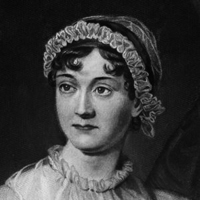Sense and Sensibility by Jane Austen: Introduction
Sense and Sensibility was first written in 1797 in an epistolary form. Later on she brought many changes in the form and content and finally published Sense and Sensibility in 1811 after fourteen years of preparation. She presents her concern in moralistic points, by writing her novel in an antithetical way, giving its title Sense and Sensibility.

Jane Austen
Sense and Sensibility represents neoclassical, dualistic moral world where the values of reason and restraint will finally become victorious over the impulsive, romantic sensibility. Not only that, she makes a severe satire of the hypocrisies of the eighteenth century society where the aristocrats are praised and indirectly influences young minds, not to value love but to betray it just for the sake of wealth. In the novel, Lucy and Willoughby symbolize this type of people of the society.
The novel in an implicit way depicts the gaps that occur between language and behavior, feeling and action. For Marianne the relationship is to be found on the unmediated openness of one freely expressive heart to another. But for Elinor marriage is a first social contract. This social contract is first mediated by a language, which preserves a rational and decorous civilization as a stay against humankind's baser instincts. The novel represents the two sisters who had a different approach to love and relationships. Marianne has chosen an impulsive and abstractly romantic path to life, love and relationship. Her chosen partner Willoughby is also unbelievably dashing handsome. But Willoughby turns out to be a wolf in sheep's clothing: he betrays Marianne. By showing the tragic collapse of Marianne-Willoughby love relation, Jane Austen is trying to warn to those who tend to find love through unrestricted impulse. Through this failure of love of Marianne, Austen is expressing her dissatisfaction towards any individual attempt to form any relationship basing on abstract emotion.
Austen highlights the life approach of Elinor that is based on the sense and reasoning. Elinor has that quality which helps her to manage her feeling at any situation, whether it be too sad or happy. She rationally and sensibly examines her relationship with Edward and its consequences. When her relation was broken up by Fanny, she perfectly controls upon her emotions and does not lose the normal framework of the mind. She possesses a good sense and because of that she can stand strong, even at the time of tragic separation from Edward. She is positively guided by her sense.
The novel presents the eighteenth century trend and the culture of love making. Moreover, it also shows what kinds of love making leads to the successful marriage. Two trends in the eighteenth century love making art are symbolized by Elinor and Marianne.
Literary Spotlight
Summary of Sense and Sensibility
Delineation of Women in Sense and Sensibility
Domestic Realism in Sense and Sensibility
Satirical Representation of Society
Compare and Contrast of Elinor and Marianne
Antithetical Structure of Sense and Sensibility
Irony in Sense and Sensibility
Realism in Sense and Sensibility
 |
bachelorandmaster.com |